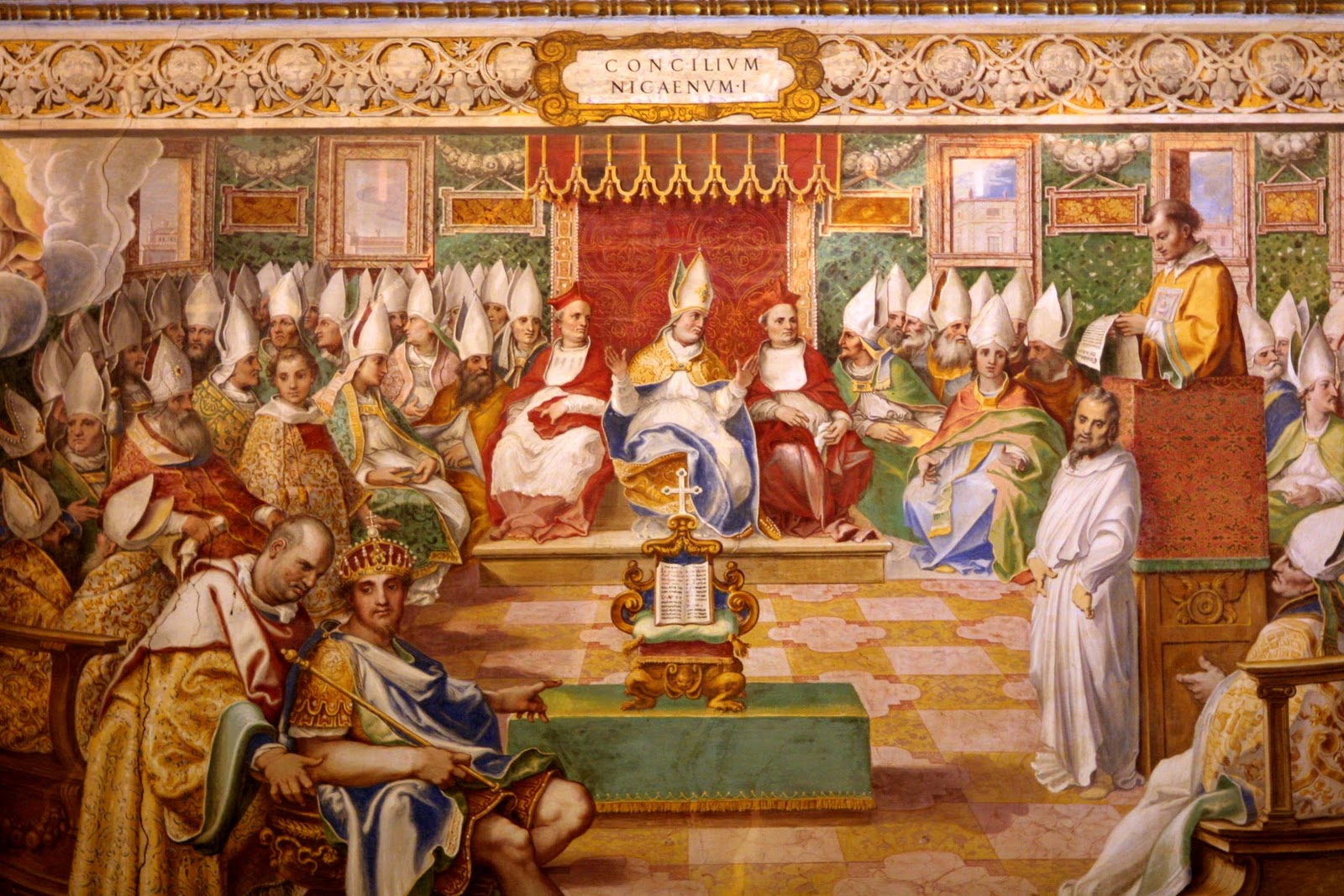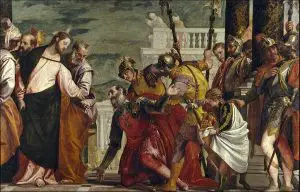Many Christians have been told that the doctrine of the Trinity was passed down through the ages, unchanged from the 1st century to the present. If this is the case, we should be able to trace a consistent creedal testimony through the chronicles of Church history. In this article, we will examine post-Biblical creedal statements as they pertain to a belief in God to determine if their theology developed over time or if it is consistent with Scripture, and therefore, the theology of the first century Church.
What is a Creed?
A creed, by definition, is a summary statement of what one believes. The word creed originates from the Latin “credo” meaning “I believe.” The Bible offers many statements which scholars consider to be creedal. One of the earliest and most foundational creeds is the one Moses taught the Jews. This Biblical creed is referred to as the Shema:[1]
Deuteronomy 6:4 (NASB) “Hear, O Israel! The LORD is our God, the LORD is one!
Jesus adhered to this creed and said that to love this singular God was the foremost commandment:
Mark 12:29-31 (NASB) Jesus answered, “The foremost is, ‘Hear O Israel! the LORD our God is one LORD; 30 and you shall love the Lord your God with all your heart, and with all your soul, and with all your mind, and will all your strength.’ 31 “The second is this, ‘You shall love your neighbor as yourself.’ There is no other commandment greater than these.”
Another statement of belief is found in Paul’s letter to the church in Corinth:
1 Corinthians 15:3-4 (NASB) For I delivered to you as of first importance what I also received, that Christ died for our sins according to the Scriptures, 4 and that He was buried, and that He was raised on the third day according to the Scriptures
Any non-canonical creedal statement must conform to the statements penned by the inspired Biblical authors. Indeed, the Westminster Confession of Faith, the famed standard from the mid-17th century, rightly acknowledges that creeds set forth by post-Biblical councils are subject to error and, in fact, many have erred:
All synods or councils, since the apostles’ times, whether general or particular, may err; and many have erred. Therefore they are not to be made the rule of faith, or practice; but to be used as a help in both.[2]
In other words, man-made creeds must yield to Scripture when at variance with God’s inspired word.
Rule of Faith
Just as the Father taught Jesus,[3] Jesus, in turn, taught the apostles who then entrusted these truths to believers who would faithfully teach others.[4] The core doctrines of these apostolic teachings or traditions came to be known as the rule of faith, a summary of essential beliefs for new converts preparing for baptism.[5] The rule of faith did not have a set form,[6] and the wording may have varied from church to church,[7] but as Everett Ferguson notes:
…the essential message was fixed by the facts of the gospel and the structure of Christian belief in one God, reception of salvation in Christ, and experience of the Holy Spirit; but each teacher had his own way of stating and elaborating these points.[8]
The Old Roman Creed
The Old Roman Creed, the earliest known post-Biblical creed, is thought to have its origins in a rule of faith. Scholars believe this creed was in use as early as 180 A.D.,[9] although there are no extant copies prior to its appearance in a letter written by Marcellus of Ancyra in about 341 A.D.[10] The creed states:
I believe in God the Father almighty;
and in Christ Jesus His only Son, our Lord,
Who was born from the Holy Spirit and the Virgin Mary,
Who under Pontius Pilate was crucified and buried,
on the third day rose again from the dead,
ascended into heaven,
sits at the right hand of the Father,
whence he will come to judge the living and the dead;
and in the Holy Spirit,
the holy Church,
the remission of sins,
the resurrection of the flesh,
[life everlasting]. (emphasis added)
This creed, which is in keeping with Scripture, states that God the Father is the almighty while Jesus is the Messiah who is seated at God’s right hand. The confessor also offers a belief in the Holy Spirit, specifically, as the power behind Jesus’ miraculous conception.
What is absent from this earliest of creeds is any statement that says Jesus pre-existed or anything else that would indicate that they believed he was God. What’s more, there is no statement indicating the Holy Spirit is God separate and apart from God the Father. These are both glaring omissions considering the doctrine of Jesus’ deity and the doctrine of the Trinity are claimed to be a part of the early Church’s theology. How much more glaring is their absence considering we’ve been told that you cannot be saved if you don’t believe in them. And yet, not even the faintest doctrinal whisper can be heard in what many scholars point to as one of the earliest statements of faith.
The Apostles’ Creed
The Old Roman Creed is believed to have provided the foundation for history’s next belief statement, the Apostles’ Creed. Its date of origin is believed to be sometime during the 3rd or 4th century.
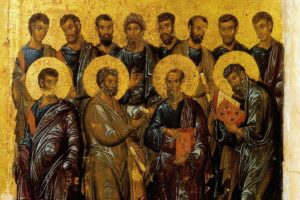
Many church goers are familiar with this creed, or at least parts of it, as later versions are often read in churches, especially those with liturgical services. The creed states:
I believe in God, the Father almighty,
creator of heaven and earth.I believe in Jesus Christ, his only Son, our Lord,
who was conceived by the Holy Spirit,
born of the Virgin Mary,
suffered under Pontius Pilate,
was crucified, died, and was buried;
On the third day he rose again;
he ascended into heaven,
he is seated at the right hand of the Father,
and he will come to judge the living and the dead.I believe in the Holy Spirit,
the holy catholic [i.e. universal] Church,
the communion of saints,
the forgiveness of sins,
the resurrection of the body,
and the life everlasting. Amen.[11] (emphasis added)
In the late 4th century[12], Tyrannius Rufinus of Aquileia wrote a commentary in 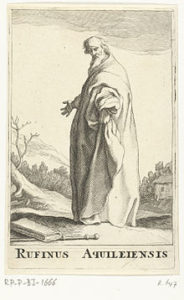 Latin on the Apostles’ Creed entitled, Commentarius in symbolum apostolorum, in which he explains his belief that the creed was authored by the apostles:
Latin on the Apostles’ Creed entitled, Commentarius in symbolum apostolorum, in which he explains his belief that the creed was authored by the apostles:
Our forefathers have handed down to us the tradition, that, after the Lord’s ascension… [the apostles] first mutually agreed upon a standard of their future preaching, lest haply, when separated, they might in any instance vary in the statements which they should make to those whom they should invite to believe in Christ. Being all therefore met together, and being filled with the Holy Ghost, they composed, as we have said, this brief formulary of their future preaching, each contributing his several sentence to one common summary: and they ordained that the rule thus framed should be given to those who believe….The apostles therefore prescribed this formulary as a sign or token by which he who preached Christ truly, according to Apostolic rule, might be recognised [sic].[13]
Some scholars contend, however, that instead of the apostles being the source of the Apostles’ Creed, it is more likely that it originated from early interrogations of catechumens or baptismal candidates. An example of such interrogations appears in The Apostolic Tradition of Hippolytus, written by the presbyter in Rome in 215 A.D. In this writing, the interrogator asks, “Do you believe…” and the baptismal candidate should respond, “I believe.” Some scholars surmise that these interrogations became the basis for the early creeds.[14] Hippolytus writes:
When each of them to be baptized has gone down into the water, the one baptizing shall lay hands on each of them, asking, “Do you believe in God the Father Almighty?” And the one being baptized shall answer, “I believe.” He shall then baptize each of them once, laying his hand upon each of their heads. Then he shall ask, “Do you believe in Jesus Christ, the Son of God, who was born of the Holy Spirit and the Virgin Mary, who was crucified under Pontius Pilate, and died, and rose on the third day living from the dead, and ascended into heaven, and sat down at the right hand of the Father, the one coming to judge the living and the dead?” When each has answered, “I believe,” he shall baptize a second time. Then he shall ask, “Do you believe in the Holy Spirit and the Holy Church and the resurrection of the flesh?” Then each being baptized shall answer, “I believe.” And thus let him baptize the third time.[15] (emphasis added)
In keeping with the Old Roman Creed, both Hippolytus’ example and the Apostles’ Creed declare that God the Father is the Almighty, while the latter adds that He is also the Creator. Jesus, on the other hand, is not designated as God, but as the Christ who bears the synonymous title of Son of God.[16] The Holy Spirit is understood to be the power behind Jesus’ miraculous conception.[17] Each of these truths can be found, chapter and verse, in the Scriptures. Even at this late date, nothing indicates that there is a universal belief in a tri-personal God whose members have a shared essence or who are co-equal and co-eternal, as is seen in later fourth century creedal developments. To be sure, the deity of Christ and the Trinity are not a part of these statements of faith.
The Creed of Nicaea
It’s not until the Council of Nicaea in 325 A.D. that creeds take a dramatic turn. Not only is the Lord Jesus said to be the Christ, the Son of God, as in previous creedal statements, the bishops, following the lead of the emperor Constantine who presided over the council, expanded Jesus’ definition to include being of the same substance or essence as God the Father. The creed produced by the 4th century council states:
We believe in one God, the father almighty, maker of heaven and earth, and of all things visible and invisible.
And in one Lord Jesus Christ, the only begotten Son of God, begotten of the Father, Light of light, very God of very God, begotten not made, being of one substance with the Father; by whom all things were made; who for us men, and for our salvation, came down from heaven, and was incarnate and was made man; He suffered, and the third day he rose again, ascended into heaven, from there he shall come to judge both the quick and the dead;
and in the Holy Spirit.[18] (emphasis added)
For the first time, both God the Father and Jesus are defined as “God” in a creedal statement, although there were differing opinions as to just what this meant. Some considered Jesus to be the one God in some sense, while others understood him to be subordinate to the one God. But notice that there is no expression of the Spirit’s deity whatsoever. In other words, in the year 325 A.D., the doctrine of the Trinity had yet to be developed or endorsed by the Church.
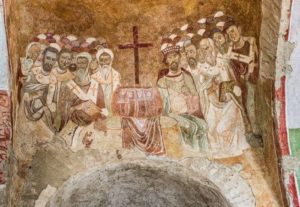
Nicaea’s creed is a marked departure, not only from the Old Roman Creed and the Apostles’ Creed but, more importantly, from Scripture. It is at odds with the Shema, the creed which Jesus adhered to,[19] which declares that God is one. In addition, the creed contradicts Jesus’ statement that the Father is the only true God, while he is the Christ:
John 17:1 and 3 (NASB) Jesus spoke these things; and lifting up His eyes to heaven, He said, “Father… 3 “This is eternal life, that they may know You, the only true God, and Jesus Christ whom You have sent. (emphasis added)
Furthermore, it contradicts Paul’s theology and Christology as well:
1 Corinthians 8:6 (NASB) yet for us there is but one God, the Father, from whom are all things and we exist for Him; and one Lord, Jesus Christ, by whom are all things, and we exist through Him. (emphasis added)
Unfortunately, the creed of Nicaea marks only the beginning of the ecumenical Church’s departure from Scripture as evidenced by their statements of faith.
The Creed of Constantinople
The Creed of Constantinople, also known as the Nicene Creed or the Nicene-Constantinopolitan Creed, is a revision of the Creed of Nicaea (325 A.D.). It was crafted in 381 A.D. during the reign of the emperor Theodosius. The creed states:
I believe in one God, the Father almighty, maker of heaven and earth, of all things visible and invisible.
I believe in one Lord Jesus Christ, the Only Begotten Son of God, born of the Father before all ages. God from God, Light from Light, true God from true God, begotten, not made, consubstantial with the Father; through him all things were made. For us men and for our salvation he came down from heaven, and by the Holy Spirit was incarnate of the Virgin Mary, and became man. For our sake he was crucified under Pontius Pilate, he suffered death and was buried, and rose again on the third day in accordance with the Scriptures. He ascended into heaven and is seated at the right hand of the Father. He will come again in glory to judge the living and the dead and his kingdom will have no end.
I believe in the Holy Spirit, the Lord, the giver of life, who proceeds from the Father [and the Son], who with the Father and the Son is adored and glorified, who has spoken through the prophets.
I believe in one, holy, catholic and apostolic Church. I confess one Baptism for the forgiveness of sins and I look forward to the resurrection of the dead and the life of the world to come. Amen. (emphasis added)
In this late 4th century creed, the Holy Spirit is now said to be Lord and the giver of life, who is to be adored and glorified along with the Father and the Son. But, it is important to note that there is no mention of the Spirit being co-eternal. This unspecified Trinity, for the word does not appear in the creed, is now the officially sanctioned view of the Church.
Subsequent creedal statements that emerged from the councils at Ephesus (431 A.D.) and Chalcedon (451 A.D.)[20] sought to deal with the confusion created by determining that Jesus has both a human nature and a divine nature and yet is one person. The councils also purposed to extinguish any competing views.
The Athanasian Creed
While the Creed of Constantinople marked the birth of the doctrine of the Trinity, the doctrine reached its maturity in the Athanasian Creed. The creed, which many scholars date to around 500 A.D., is named after, but not written by the 4th century Athanasius of Alexandria. Now, for the first time, the Church Fathers give a fuller creedal definition and explanation of their triune God. Even more alarming, for the first time, a creedal statement contains the threat of eternal damnation for those who do not hold to the council’s view.
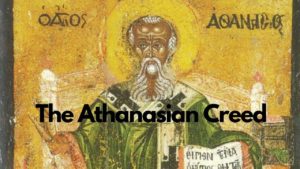
Space limitations will not permit the inclusion of this rather lengthy creed, however, a summation of key portions should suffice for our discussion. The creed begins:
Whoever desires to be saved should above all hold to the catholic faith. Anyone who does not keep it whole and unbroken will doubtless perish eternally. Anyone who does not keep it whole and unbroken will doubtless perish eternally.
The creed goes on to explain that each member of the Godhead is a separate and distinct person from the other, and they are not to be blended or confounded. The Father, Son, and Holy Spirit each possess equal glory and eternal majesty. Each is uncreated, immeasurable, and eternal. It says:
The Father is almighty, the Son is almighty, the Holy Spirit is almighty. Yet there are not three almighty beings; there is but one almighty being.
Immediately, we recognize that the Athanasian Creed has altered the Old Roman Creed and Apostles’ Creed to include Jesus and the Spirit as being almighty in addition to God the Father. Yet, somehow there is only one almighty God and not three. The creed continues:
Thus the Father is God, the Son is God, the Holy Spirit is God. Yet there are not three gods; there is but one God.
Thus the Father is Lord, the Son is Lord, the Holy Spirit is Lord. Yet there are not three lords; there is but one Lord.
Anyone then who desires to be saved should think thus about the trinity.
The text then gives a detailed statement describing Jesus as being equally God and human, and yet he is somehow not two persons:
That we believe and confess that our Lord Jesus Christ, God’s Son, is both God and human, equally.
He is God from the essence of the Father, begotten before time; and he is human from the essence of his mother, born in time; completely God, completely human, with a rational soul and human flesh; equal to the Father as regards divinity, less than the Father as regards humanity.
Although he is said to be both God and human, yet Christ is not two, but one. He is one, however, not by his divinity being turned into flesh, but by God’s taking humanity to himself. He is one, certainly not by the blending of his essence, but by the unity of his person. For just as one human is both rational soul and flesh, so too the one Christ is both God and human.
The creed concludes with the same admonition with which it began:
This is the catholic faith: one cannot be saved without believing it firmly and faithfully.[21]
If these claims are true, they would be considered foundational to the Christian faith. And yet, they do not appear in the Church’s earliest theology as evidenced by the statements of faith. If Jesus is indeed both God and man, why do the Old Roman Creed, the Apostles’ Creed, and Hippolytus’ primer completely omit such important “truths?” Why do they simply refer to Jesus as the Christ? Why doesn’t Scripture teach these late creedal doctrines? More importantly, why does Scripture contradict them? Indeed, Scripture not only fails to instruct us about a triune God, it never demands that we must believe in one in order to escape the flames of hell.

Tragically, the ecumenical creedal statements reflect the beliefs of Hellenized Church Fathers who infused their Platonic worldview into the Scriptures. The Encyclopedia of Early Christianity explains that doctrine of the Trinity was shaped during the period of the Church Fathers:
It was during the patristic centuries that the church’s Trinitarian faith assumed the shape it has largely retained throughout its history. Athanasius and the Cappadocians in the fourth century, and later Augustine, played a formative role. The Nicene and “Athanasian” Creeds embody the determination of the fathers on the Trinity.[22] (emphasis added)
Some may counter that the creedal statements evolved because the first century Christians did not have the language necessary to be able to communicate such complicated doctrines. However, this reflects more of a belief that God is somehow limited because He could not overcome this perceived obstacle. But God is more than capable of communicating in any language and to all levels of intelligence. Without a doubt, God fully communicated the entire gospel message to the early Church as seen in the angel’s command to Peter once he was miraculously released from prison:
Acts 5:20 (NASB) “Go, stand and speak to the people in the temple the whole message of this Life.” (emphasis added)
The early Church received the whole message of this life, not a partial doctrine that would require four centuries for the Church Fathers to fill in the missing pieces.
The Lord’s brother also testified that the complete faith had been handed down to the saints:
Jude 1:3 (Amplified Bible) … I was compelled to write to you [urgently] appealing that you fight strenuously for [the defense of] the faith which was once for all handed down to the saints [the faith that is the sum of Christian belief that was given verbally to believers]. (emphasis added)
Others may offer that it is acceptable for doctrinal truths to evolve, to which we would respond that the God-breathed Scriptures are adequate for our instruction:
2 Timothy 3:16-17 (NASB) All Scripture is inspired by God and profitable for teaching, for reproof, for correction, for training in righteousness; 17 so that the man of God may be adequate, equipped for every good work. (emphasis added)
What’s more, the apostle Paul assured the church in Ephesus that he withheld nothing that was profitable for believers:
Acts 20:20-21 and 27 (NASB) …I did not shrink from declaring to you anything that was profitable and teaching you publicly and from house to house, 21 solemnly testifying to both Jews and Greeks of repentance toward God and faith in our Lord Jesus Christ… 27 “For I did not shrink from declaring to you the whole purpose of God. (emphasis added)
Yet no Biblical author taught Jesus is God or that the one God of the Shema is actually a tri-fold deity. And nowhere in Scripture are we warned that a failure to believe in the deity of Christ or the Trinity is grounds for eternal damnation. Never.
Pinchas Lapide, an Israeli historian and theologian specializing in the New Testament, offers this insightful observation about the development of dogma:
Whoever knows the development of history of dogma, knows that the image of God in the primitive Church was a unitarian one. Only in the second century did it gradually, against the doctrine of subordinationism, become binary. For the church fathers, such as Justin Martyr, Irenaeus, Tertullian, Jesus is subordinated to the Father in everything and Origen hesitated to still direct his prayers to Christ, for as he wrote, that should properly be to the Father alone. At this point he referred to the words of Jesus in the Gospel of John: “The Father who has sent me is greater than I.”
The total picture which arises from history is almost like an arithmetic progression: In the first century, God is still monotheistic in good Jewish fashion. In the second century God becomes two in one; from the third century on, God gradually becomes threefold. Only in the fourth century does the elevation of the Holy Spirit with a special hypostatis with its own value take place.[23] (emphasis added)
Contrary to what we have been told, the doctrine of Jesus’ deity and the doctrine of the Trinity were not passed down through the ages from the first century Church to the present. To be sure, the creedal statements bear witness that the Hellenized Church strayed beyond the confines of what we’ve been taught in Scripture. Tragically, the Church Fathers replaced the authority of God’s word with the traditions of men.
[1] Shema or shama is the word hear or listen in Hebrew, which is the first word in Deuteronomy 6:4.
[2] The Westminster Confession of Faith, Chapter XXXI, Of Synods and Councils, 1646. https://www.ccel.org/ccel/anonymous/westminster3.i.xxxiv.html
[3] John 8:28; Matthew 28:20.
[4] 2 Timothy 2:2
[5] Rick Wade, Scripture and Tradition in the Early Church. 5-27-01, accessed 9-8-20, https://probe.org/scripture-and-tradition-in-the-early-church/
[6] Ibid.
[7] Rule of Faith, Oxford Reference, https://www.oxfordreference.com/view/10.1093/oi/authority.20110803100432974
[8] Everett Fergus, The Rule of Faith, as quoted by Rick Wade in Scripture and Tradition in the Early Church, 5-27-01, accessed 9-8-20, https://probe.org/scripture-and-tradition-in-the-early-church/
[9] http://www.thisischurch.com/christian_teaching/booklets/credo_3.htm#Roman
[10]https://blog.faithlife.com/blog/2015/04/the-apostles-creed-its-history-and-origins/
[11] https://www.learnreligions.com/the-apostles-creed-p2-700364
[12] Approximately 391 AD.
[13] The Nicene and Post-Nicene Fathers, Series II, Volume 3, Phillip Schaff, WM B. Eerdmans, Grand Rapids, MI, https://www.ccel.org/ccel/schaff/npnf203.vi.xiii.iii.html
[14] https://www.britannica.com/topic/Apostles-Creed
[15] http://www.stjohnsarlingtonva.org/Customer-Content/saintjohnsarlington/CMS/files/EFM/Apostolic_Tradition_by_Hippolytus.pdf
[16] John 1:49; Matthew 26:63.
[18] Philip Schaff, Creeds of Christendom, Vol. 1, Harper and Brothers, New York, 1877, p. 28-29.
[20] The Creed of Chalcedon, https://bible.org/illustration/creed-chalcedon-ad-451
[21] https://www.crcna.org/welcome/beliefs/creeds/athanasian-creed
[22] Daniel F. Wright, Encyclopedia of Early Christianity, Second Edition, Everett Ferguson, ed. (NY: Garland Publishing, 1999), pg 1142.
[23] Pinchas Lapide, Jewish Monotheism and Christian Trinitarian Doctrine: A Dialogue by Pinchas Lapide and Jurgen Moltmann, (Philadelphia: Fortress Press), 1981, p.39.
